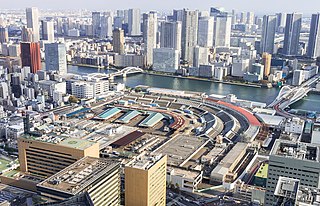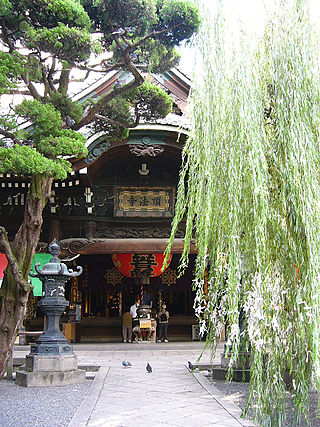| Statue of Shinran | |
|---|---|
 The statue in 2018 | |
 | |
| Subject | Shinran |
| Location | Tokyo, Japan |
| 35°39′59.6″N139°46′16.5″E / 35.666556°N 139.771250°E | |
A statue of Shinran is installed outside Tsukiji Hongan-ji in Tokyo, Japan.
- The statue, 2019
| Statue of Shinran | |
|---|---|
 The statue in 2018 | |
 | |
| Subject | Shinran |
| Location | Tokyo, Japan |
| 35°39′59.6″N139°46′16.5″E / 35.666556°N 139.771250°E | |
A statue of Shinran is installed outside Tsukiji Hongan-ji in Tokyo, Japan.

Shinran was a Japanese Buddhist monk, who was born in Hino at the turbulent close of the Heian Period and lived during the Kamakura Period. Shinran was a pupil of Hōnen and the founder of what ultimately became the Jōdo Shinshū sect of Japanese Buddhism.

Jōdo Shinshū, also known as Shin Buddhism or True Pure Land Buddhism, is a school of Pure Land Buddhism. It was founded by the former Tendai Japanese monk Shinran.

Chūō is a special ward in the Tokyo Metropolis in Japan. The ward refers to itself in English as Chūō City. It was formed in 1947 as a merger of Kyobashi and Nihonbashi wards following Tokyo City's transformation into Tokyo Metropolis.

A maguro bōchō, or maguro kiri bōchō, is an extremely long, highly specialized Japanese knife that is commonly used to fillet tuna, as well as many other types of large ocean fish.

Tsukiji Market is a major tourist attraction for both domestic and overseas visitors in Tokyo. The area contains retail markets, restaurants, and associated restaurant supply stores. Before 2018, it was the largest wholesale fish and seafood market in the world. The market opened on 11 February 1935 as a replacement for an older market that was destroyed in the 1923 Great Kantō earthquake. It was closed on 6 October 2018, with wholesale operations moving to the new Toyosu Market.

Tsukiji (築地) is a district of Chūō, Tokyo, Japan. Literally meaning "reclaimed land", it lies near the Sumida River on land reclaimed from Tokyo Bay in the 18th century during the Edo period. The eponymous Tsukiji fish market opened in 1935 and closed in 2018 when its operations were moved to the new Toyosu Market.

Rennyo was the 8th Monshu of the Hongan-ji Temple of the Jōdo Shinshū sect of Buddhism, and descendant of founder Shinran. Jodo Shinshu Buddhists often referred to him as the restorer of the sect. He was also known as Shinshō-in (信証院), and posthumously Etō Daishi (慧灯大師). During the conflict of the Ōnin War and the subsequent warfare that spread throughout Japan, Rennyo was able to unite most of the disparate factions of the Jodo Shinshu sect under the Hongan-ji, reform existing liturgy and practices, and broaden support among different classes of society. Through Rennyo's efforts, Jodo Shinshu grew to become the largest, most influential Buddhist sect in Japan.

Hongan-ji, also archaically romanized as Hongwanji, is the collective name of the largest school of Jōdo Shinshū Buddhism. 'Hongan-ji' may also refer to any one of several actual temple buildings associated with the sect. Nishi Honganji (西本願寺) and Higashi Honganji (東本願寺) are two major temples in Kyoto.

Ushiku Daibutsu (牛久大仏) is a statue located in Ushiku, Ibaraki Prefecture, Japan. Completed in 1993, it stands a total of 120 metres (390 ft) tall, including the 10 m (33 ft) base and 10 m lotus platform. The statue held the record for the tallest statue from 1993 to 2008. As of 2023, it is the fifth-tallest statue in the world.

Tsukiji Hongan-ji (築地本願寺), sometimes archaically romanized Hongwan-ji, is a Jodo Shinshu Buddhist temple located in the Tsukiji district of Tokyo, Japan.

The Sumida River is a river that flows through central Tokyo, Japan. It branches from the Arakawa River at Iwabuchi and flows into Tokyo Bay. Its tributaries include the Kanda and Shakujii rivers.

A fish market is a marketplace for selling fish and fish products. It can be dedicated to wholesale trade between fishermen and fish merchants, or to the sale of seafood to individual consumers, or to both. Retail fish markets, a type of wet market, often sell street food as well.
Senju-ji (専修寺), also known as Takadayama (高田山), refers to a pair of temples which are the chief Buddhist temples of the Takada branch of Jōdo Shinshū, a Japanese Buddhist sect. The current head temple, Honan Senju-ji, founded in the 15th century, is located in Mie Prefecture. The original head temple, Hon-ji Senju-ji, founded in 1225, is located in Tochigi Prefecture. Both temples are governed by the same abbot.

Tsukijishijō Station is a subway station in Chūō, Tokyo, Japan operated by the Tokyo subway operator Toei Subway. It serves the lower part of the Tsukiji district, including the enormous Tokyo Metropolitan Central Wholesale Market, the Tokyo headquarters of the Asahi Shimbun newspaper, and Japan's National Cancer Center.
The Monshu (門主), or keeper of the gate is a term sometimes used in Japanese Buddhism to denote the head of a monastery, as in the case of Jōdo-shū and Tendai Buddhism, but in the case of the Nishi Hongan-ji sub-sect of Jōdo Shinshū Buddhism, it refers to the spiritual leader of the sect, and direct descendant of its founder Shinran.
Shinran: Path to Purity is a 1987 Japanese drama film directed by Rentarō Mikuni, based on Mikuni's novel of the same name. The film follows the life and struggles of the Jodo Shinshu founder, Shinran, during the tumultuous Heian era. The film won the Jury Prize at the 1987 Cannes Film Festival.

The Rokkaku-dō, official name Chōhō-ji, is a Buddhist temple in Kyoto, Japan, said to have been established by Prince Shōtoku. The name comes from its main hall's hexagonal shape. This temple is part of the Saigoku Kannon Pilgrimage.

Toyosu (豊洲) is neighborhood in Kōtō, Tokyo. Toyosu has six numbered chome ("blocks"). It is the location of the wholesale Toyosu Market, which took the role of the Tsukiji fish market after it became solely a tourist attraction.

The Hongan-ji Nagoya Betsuin (本願寺派名古屋別院) is a Jōdo Shinshū Buddhist temple located in Naka ward, Nagoya in central Japan.